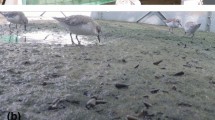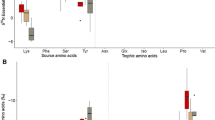Abstract
We used stable isotopes of C in breath, blood, feces and feathers to identify intra-individual changes in diet and the timescale of diet changes in free-living songbirds at a stopover site. Because accurate interpretation of differences between the δ13C of breath, plasma, and red blood cells (RBCs) relative to diet requires knowing the turnover rate of C within them, we determined the rate of change of C in breath, plasma and RBCs for yellow-rumped warblers (Dendroica coronata). Half-lives of C in breath, plasma, and RBCs were 4.4±2.1 h, 24.8±12.3 h and 10.9±3.2 days, respectively, for yellow-rumped warblers. δ13C of breath, plasma, RBCs and feces from wild-caught golden-crowned kinglets (Regulus satrapa), ruby-crowned kinglets (R. calendula) and gray catbirds (Dumetella carolinensis) indicated that they had maintained an isotopically consistent diet for an extended period of time. However, δ13C of breath and plasma indicated that white-throated sparrows (Zonotrichia albicollis) had recently expanded their diet to include a C4 dietary component. Likewise, δ13C of breath, plasma, RBCs and feces indicated that some wild-caught yellow-rumped warblers had consumed foods with a more enriched protein signature prior to their arrival on Block Island, and since arrival, they had consumed mostly northern bayberry (Myrica pensylvanica). Therefore, comparisons of the δ13C of breath, plasma, RBCs, feces and feathers from individual songbirds can indicate changes in diet and provide an estimate of the timescale of the diet change.




Similar content being viewed by others
References
Afik D, McWilliams SR, Karasov WH (1997) A test for passive absorption of glucose in yellow-rumped warblers and its ecological implications. Physiol Zool 70:370–377
Alexander SA, Hobson KA, Gratto-Trevor CL, Diamond AW (1996) Conventional and isotopic determinations of shorebird diets at an inland stopover: the importance of invertebrates and Potamogeton pectinatus tubers. Can J Zool 74:1057–1068
Ayliffe LK, Cerling TE, Robinson T, West AG, Sponheimer M, Passey BH, Hammer J, Roeder B, Dearing MD, Ehleringer JR (2004) Turnover of carbon isotopes in tail hair and breath CO2 of horses fed an isotopically varied diet. Oecologia 139:11–22
Bairlein F (1987) Nutritional requirements for maintenance of body weight and fat deposition in the long-distance migratory garden warbler, Sylvia Borin (Boddaert). Comp Biochem Physiol 86A:337–347
Bairlein F (1990) Nutrition and food selection in migratory birds. In: Gwinner E (ed) Bird migration. Springer, Berlin Heidelberg New York, pp 198–213
Bauchinger U, Biebach H (1998) The role of protein during migration in passerine birds. Biol Conserv Fauna 102:299–305
Bearhop S, Waldron S, Votier SC, Furness RW (2002) Factors that influence assimilation rates and fractionation of nitrogen and carbon stable isotopes in avian blood and feathers. Physiol Biochem Zool 75:451–458
Ben-David M, Flynn RW, Schell DM (1997) Annual and seasonal changes in diets of martens: evidence from stable isotope analysis. Oecologia 111:280–291
Bordel R, Haase E (2000) Influence of flight on protein catabolism, especially myofilament breakdown, in homing pigeons. J Comp Physiol B 170:51–58
Chamberlain CP, Blum JD, Holmes RT, Feng X, Sherry TW, Graves GR (1997) The use of isotope tracers for identifying populations of migratory birds. Oecologia 109:132–141
DeNiro MJ, Epstein S (1978) Influence of diet on the distribution of carbon isotopes in animals. Geochim Cosmochim Acta 42:495–506
Evans Ogden LJ, Hobson KA, Lank DB (2004) Blood isotopic (δ13C and δ15N) turnover and diet-tissue fractionation factors in captive dunlin (Calidris alpina pacifica). Auk 121:170–177
Frazer KI, McWilliams SR (2002) Determinants of dietary preference in yellow-rumped warblers. Wilson Bull 114:243–248
Gannes LZ, O’Brien DM, Martínez del Rio C (1997) Stable isotopes in animal ecology: assumptions, caveats, and a call for more laboratory experiments. Ecology 78:1271–1276
Gannes LZ, Martínez del Rio C, Koch P (1998) Natural abundance variations in stable isotopes and their potential uses in animal physiological ecology. Comp Biochem Physiol A 119:725–737
Graves GR, Romanek CS, Navarro AR (2002) Stable isotope signature of philopatry and dispersal in a migratory bird. Proc Natl Acad Sci USA 99:8096–8100
Haramis MG, Jorde DG, Macko SA, Walker JL (2001) Stable-isotope analysis of canvasback winter diet in upper Chesapeake Bay. Auk 118:1008–1017
Harding EK, Stevens E (2001) Using stable isotopes to assess seasonal patterns of avian predation across a terrestrial-marine landscape. Oecologia 129:436–444
Hatch KA, Pinshow B, Speakman JR (2002a) The analysis of 13C/12C ratios in exhaled CO2: its advantages and potential application to field research to infer diet, changes in diet over time, and substrate metabolism in birds. Integr Comp Biol 42:21–33
Hatch KA, Pinshow B, Speakman JR (2002b) Carbon isotope ratios in exhaled CO2 can be used to determine not just present, but also past diets in birds. J Comp Physiol B 172:263–268
Hilderbrand GV, Farley SD, Robbins CT, Hanley TA, Titus K, Servheen C (1996) Use of stable isotopes to determine diets of living and extinct bears. Can J Zool 74:2080–2088
Hobson KA (1999) Tracing origins and migration of wildlife using stable isotopes: a review. Oecologia 120:314–326
Hobson KA, Bairlein F (2003) Isotopic fractionation and turnover in captive Garden Warblers (Sylvia borin): implications for delineating dietary and migratory associations in wild passerines. Can J Zool 81:1630–1635
Hobson KA, Clark RG (1992a) Assessing avian diets using stable isotopes I: turnover of 13C in tissues. Condor 94:181–188
Hobson KA, Clark RG (1992b) Assessing avian diets using stable isotopes II: factors influencing diet-tissue fractionation. Condor 94:189–197
Hobson KA, Clark RG (1993) Turnover of 13C in cellular and plasma fractions of blood: implications for nondestructive sampling in avian dietary studies. Auk 110:638–641
Hobson KA, Wassenaar LI (1997) Linking breeding and wintering grounds of neotropical migrant songbirds using stable hydrogen isotopic analysis of feathers. Oecologia 109:142–148
Hobson KA, McLellan BN, Woods JG (2000a) Using stable carbon (δ13C) and nitrogen (δ15N) isotopes to infer trophic relationships among black and grizzly bears in the upper Columbia River Basin, British Columbia. Can J Zool 78:1332–1339
Hobson KA, Sirois J, Gloutney ML (2000b) Tracing nutrient allocation to reproduction with stable isotopes: a preliminary investigation using colonial waterbirds of Great Slave Lake. Auk 117:760–774
Kelly JF (2000) Stable isotopes of carbon and nitrogen in the study of avian and mammalian trophic ecology. Can J Zool 78:1–27
Levey DJ, Karasov WH (1989) Digestive responses of temperate birds switched to fruit or insect diets. Auk 106:675–686
MacAvoy SE, Macko SA, Garman GC (2001) Isotopic turnover in aquatic predators: quantifying the exploitation of migratory prey. Can J Fish Aquat Sci 58:923–932
Marra PP, Hobson KA, Holmes RT (1998) Linking winter and summer events in a migratory bird by using stable-carbon isotopes. Science 282:1884–1886
Martínez del Rio C, Wolf BO (2004) Mass balance models for animal isotopic ecology. In: Starck JM, Wang T (eds) Physiological consequences of feeding. Springer, Berlin Heidelberg New York
Mizutani H, Fukuda M, Kabaya Y (1992) 13C and 15N enrichment factors of feathers of 11 species of adult birds. Ecology 73:1391–1395
Moore FR, Kerlinger P (1987) Stopover and fat deposition by North American wood-warblers (Parulinae) following spring migration over the Gulf of Mexico. Oecologia 74:47–54
Moore FR, Gauthreaux SA, Kerlinger P, Simons TR (1995) Habitat requirements during migration: important link in conservation. In: Martin TE, Finch DM (eds) Ecology and management of neotropical migratory birds. Oxford University Press, Oxford, pp 121–144
Parrish JD (1997) Patterns of frugivory and energetic condition in nearctic landbirds during autumn migration. Condor 99:681–697
Parrish JD (2000) Behavioral, energetic, and conservation implications of foraging plasticity during migration. Stud Avian Biol 20:53–70
Pearson SF, Levey DJ, Greenberg CH, Martínez del Rio C (2003) Effects of elemental composition on the incorporation of dietary nitrogen and carbon isotopic signatures in an omnivorous songbird. Oecologia 135:516–523
Piersma T (2002) Energetic bottlenecks and other design constraints in avian annual cycles. Integr Comp Biol 42:51–67
Place AR, Stiles EW (1992) Living off the wax of the land: bayberries and yellow-rumped warblers. Auk 109:334–345
Post DM (2002) Using stable isotopes to estimate trophic posititon: models, methods, and assumptions. Ecology 83:703–718
Post DM (2003) Individual variation in the timing of ontogenetic niche shifts in largemouth bass. Ecology 84:1298–1310
Pyle P (1997) Identification guide to North American birds. Part 1. Columbidae to Plociedae. Slate Creek Press, Bolinas
Rubenstein DR, Chamberlain CP, Holmes RT, Ayres MP, Waldbauer JR, Graves GR, Tuross NC (2002) Linking breeding and wintering ranges of a migratory songbird using stable isotopes. Science 295:1062–1065
Russell RW, Carpenter FL, Hixon MA, Paton DC (1994) The impact of variation in stopover habitat quality on migrant rufous hummingbirds. Conserv Biol 8:483–490
Schaub M, Jenni L (2001) Stopover durations of three warbler species along their autumn migration route. Oecologia 128:217–227
Tieszen LL, Fagre T (1993) Effect of diet quality and composition on the isotopic composition of respiratory CO2, bone collagen, bioapatite, and soft tissues. In: Lambert JB, Grupe G (eds) Prehistoric human bone archaeology at the molecular level. Springer, Berlin Heidelberg New York, pp 120–155
Tieszen LL, Boutton TW, Tesdahl KG, Slade NA (1983) Fractionation and turnover of stable carbon isotopes in animal tissues: implications for δ13C analysis of diet. Oecologia 57:32–37
Witmer MC (1998) Ecological and evolutionary implications of energy and protein requirements of avian frugivores eating sugary diets. Physiol Zool 71:599–610
Wolf BO, Martínez del Rio C (2000) Use of saguaro fruit by white-winged doves: isotopic evidence of a tight ecological association. Oecologia 124:536–543
Wolf BO, Martínez del Rio C, Babson J (2002) Stable isotopes reveal that saguaro fruit provides different resources to two desert dove species. Ecology 83:1286–1293
Acknowledgements
This research was made possible with major assistance in the field from The Nature Conservancy and especially Scott Comings. We thank Dr David Post, Dr Carlos Martínez del Rio and an anonymous reviewer for suggestions that enhanced this manuscript. We also thank Dan Eggers, Jennifer Hayford, Brooke Harris, Chris Halstead, Zach Ladin, Anthony Lanham, Katie McPherson, Martina Muller and Eric Walsh for help in the care and maintenance of the captive warblers. Lastly, we thank the Atlantic Ecology Division of the EPA, and especially Rick McKinney, for generously allowing use of their mass spectrometer. This is contribution no. 4063 of the University of Rhode Island Agricultural Experiment Station. This work was supported by USDA grant no. 538748, National Science Foundation IBN-9984920 and Sigma Xi. Use of wild birds in this research was authorized by the University of Rhode Island IACUC protocol no.A98-09-012 (Scott McWilliams), USFWS subpermittee (David W. Podlesak) under Master Bander (Scott R. McWilliams) no. 22923-A, and Rhode Island Department of Environmental Management, Division of Fish and Wildlife subpermittee (David W. Podlesak) under (Scott R. McWilliams) no. 2001–75C.
Author information
Authors and Affiliations
Corresponding author
Rights and permissions
About this article
Cite this article
Podlesak, D.W., McWilliams, S.R. & Hatch, K.A. Stable isotopes in breath, blood, feces and feathers can indicate intra-individual changes in the diet of migratory songbirds. Oecologia 142, 501–510 (2005). https://doi.org/10.1007/s00442-004-1737-6
Received:
Accepted:
Published:
Issue Date:
DOI: https://doi.org/10.1007/s00442-004-1737-6




